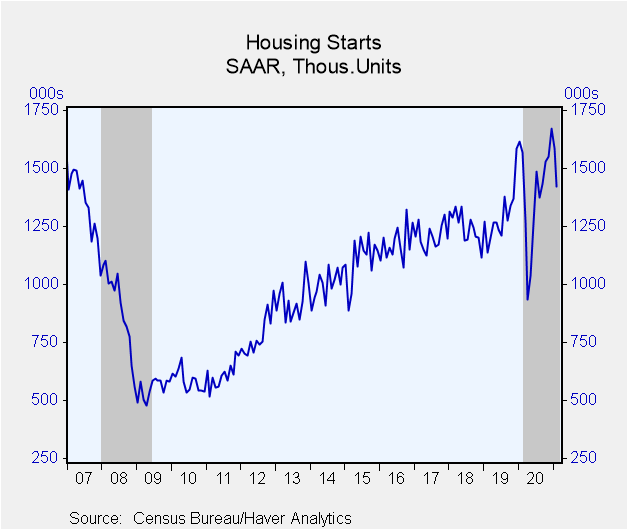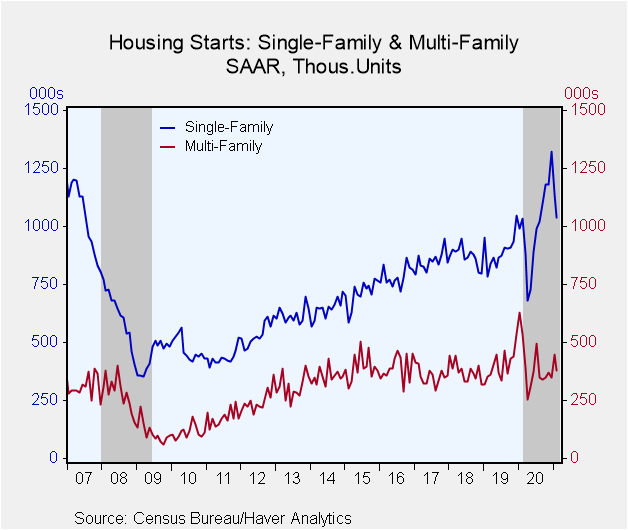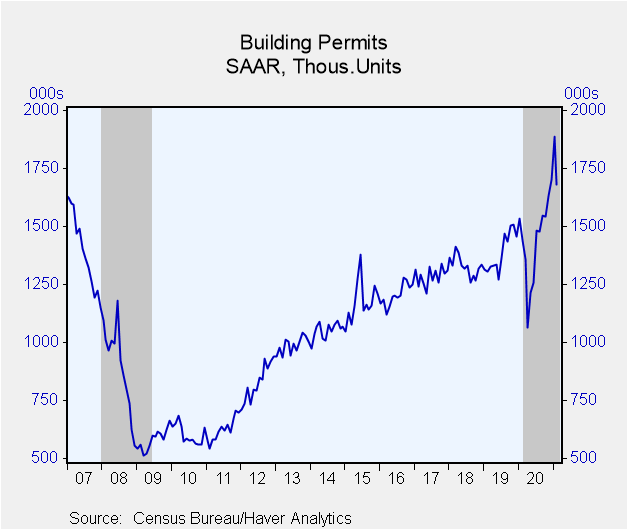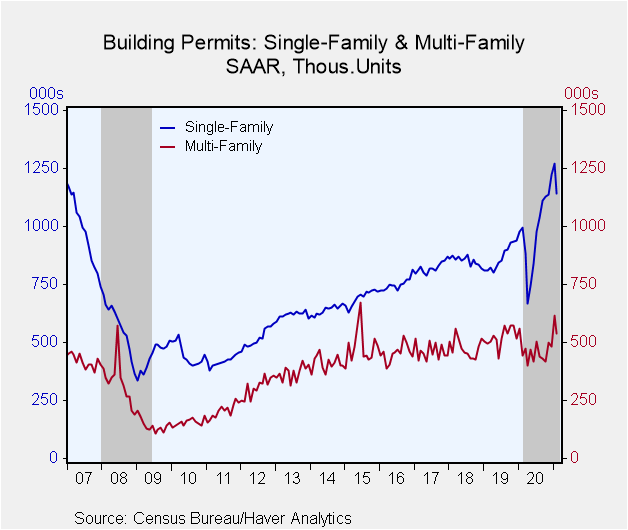 Global| Mar 17 2021
Global| Mar 17 2021U.S. Housing Starts Fall Sharply in February
by:Tom Moeller
|in:Economy in Brief
Summary
• Harsh winter weather limits building activity. • Single-family & multi-family starts fall sharply. • Building permits weaken. Housing starts declined 10.3% (-9.3% y/y) during February to 1.421 million (SAAR) from 1.584 million in [...]
• Harsh winter weather limits building activity.
• Single-family & multi-family starts fall sharply.
• Building permits weaken.
Housing starts declined 10.3% (-9.3% y/y) during February to 1.421 million (SAAR) from 1.584 million in January, revised from 1.580 million. December starts were revised to 1.670 million from 1.680 million. The Action Economics Forecast Survey expected 1.548 million starts in February.
Ice & snow storms caused starts of single-family homes to fall 8.5% (+0.6% y/y) to 1.040 million from 1.136 million in January, revised from 1.162 million. Adding to this decline was a 15.0% decrease (-28.5% y/y) in multi-family starts to 381,000 from 448,000 in January, revised from 418,000.
A 10.8% February decline (+17.0% y/y) in building permits to 1.682 million reversed all of the prior month's increase. The February level of permits was the lowest in three months. Permits to build single-family homes declined 10.0% (+15.0% y/y) to 1.143 million following a 3.8% January gain. Permits to build multi-family homes weakened 12.5% (+21.4% y/y) to 539,000 from 616,000 in January.
By region, housing starts in the Northeast fell just over one-third (-2.5% y/y) to 118,000 after rising 43.4% in January. In the Midwest, starts also fell by roughly one-third (-29.9% y/y) to 138,000 following January's 13.8% decline. Housing starts in the South weakened 9.7% (-16.6% y/y) to 725,000 following January's 4.4% decline. In the West, building activity wasn't dampened by the weather and starts increased 17.6% (15.8% y/y) to 440,000 after falling 16.5% during January.
The housing starts and permits figures can be found in Haver's USECON database. The expectations figure is contained in the AS1REPNA database.
| Housing Starts (000s, SAAR) | Feb | Jan | Dec | Feb Y/Y % | 2020 | 2019 | 2018 |
|---|---|---|---|---|---|---|---|
| Total | 1,421 | 1,584 | 1,670 | -9.3 | 1,395 | 1,295 | 1,248 |
| Single-Family | 1,040 | 1,136 | 1,322 | 0.6 | 1,000 | 893 | 872 |
| Multi-Family | 381 | 448 | 348 | -28.5 | 396 | 403 | 376 |
| Starts By Region | |||||||
| Northeast | 118 | 195 | 136 | -2.5 | 113 | 115 | 111 |
| Midwest | 138 | 212 | 246 | -29.9 | 193 | 170 | 170 |
| South | 725 | 803 | 840 | -16.6 | 741 | 689 | 630 |
| West | 440 | 374 | 448 | 15.8 | 348 | 322 | 337 |
| Building Permits | 1,682 | 1,886 | 1,704 | 17.0 | 1,438 | 1,386 | 1,329 |
Tom Moeller
AuthorMore in Author Profile »Prior to joining Haver Analytics in 2000, Mr. Moeller worked as the Economist at Chancellor Capital Management from 1985 to 1999. There, he developed comprehensive economic forecasts and interpreted economic data for equity and fixed income portfolio managers. Also at Chancellor, Mr. Moeller worked as an equity analyst and was responsible for researching and rating companies in the economically sensitive automobile and housing industries for investment in Chancellor’s equity portfolio. Prior to joining Chancellor, Mr. Moeller was an Economist at Citibank from 1979 to 1984. He also analyzed pricing behavior in the metals industry for the Council on Wage and Price Stability in Washington, D.C. In 1999, Mr. Moeller received the award for most accurate forecast from the Forecasters' Club of New York. From 1990 to 1992 he was President of the New York Association for Business Economists. Mr. Moeller earned an M.B.A. in Finance from Fordham University, where he graduated in 1987. He holds a Bachelor of Arts in Economics from George Washington University.










